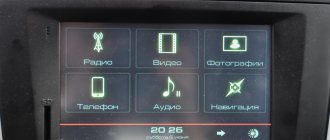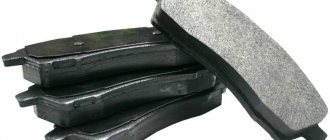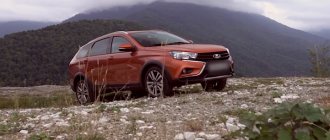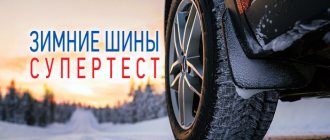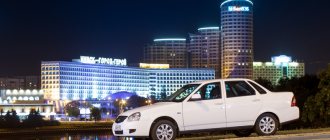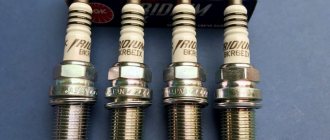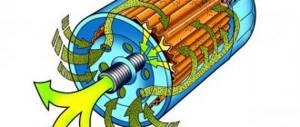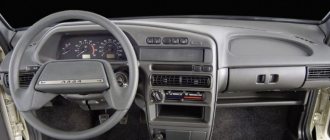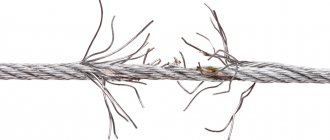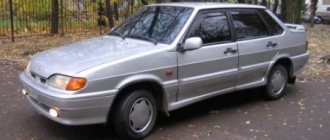- Car testing
- Damage to the driver and passenger
- Vehicle damage
- Decreased points
- Test results
- Vehicle safety equipment
Every driver hopes to avoid accidents on the road. But to choose the right tactics on the road, you need to know what the car is capable of and what its internal reserves are. To do this, it is better to have an idea of how cars are tested for strength, how to protect the car, and familiarize yourself with the results shown by the crash test of the VAZ 2114.
Crash test vaz 2114
Car testing
World standards for vehicle inspection are approved by the international organization EuroNCAP. It also checks most new machine models before putting them on production line and issues safety certificates. The test is carried out using a special technique, including testing the machine for strength while simultaneously recording a video report and taking readings from sensors that transmit data on overloads to the computer.
As a result of the test, the car is awarded points, which are an indicator of its active and passive safety. Despite the lack of data on official EuroNCAP tests for the VAZ 2114, there are independent laboratories in Russia that conduct similar tests using the EuroNCAP method.
Head-on collision
The test consists of three stages:
- Head-on collision at 64 km/h with a stationary obstacle.
- Side collision.
- Collision with a pole.
Head-on collision effect
Safety assessments are carried out for:
- driver and front passenger safety;
- child safety;
- pedestrian safety.
The assessment includes the level of vehicle damage and the condition of electronic safety features after collisions.
Result of a head-on collision
In 2004, Autoreview magazine conducted a partial crash test using the EuroNCAP method. Only frontal collision risks were assessed.
How 2114 was checked for safety
The test was carried out a long time ago, in 2004, and at that time 2114 could no longer be called a new product, which is probably why the data became available. We were well aware that Chinese cars from five years ago literally fell apart in crash tests. Thus, a 2010 Chery Amulet at a test speed of 64 km/h in a frontal collision with an overlap area of 40% will not be able to protect either the driver or passengers from injuries incompatible with life. This car did not receive a single point in the EuroNCAP tests.
According to the EuroNCAP method, the VAZ 2114 turned out to be less safe than the 2109, on the basis of which it was built. We won’t explain why this happened, we’ll just get acquainted with the test conditions. EuroNCAP conducts the test in three stages - a frontal collision with a stationary obstacle at a speed of 64 km/h, a side collision and a drift collision with a pole. In principle, the most terrible accidents are simulated, but at not the most terrible speeds. Based on the test results, the car is given points in the following categories:
- driver and front passenger safety;
- child passenger safety;
- pedestrian safety.
The level of damage to the vehicle and the functionality of electronic safety equipment are also assessed. The crash test of the VAZ 2114 did not even take all this into account. They tested only the frontal collision, and this is what came out of it.
Damage to the driver and passenger
During the collision, the dummy hit its head first on the rim and then on the steering wheel hub. At the same time, the sensors showed that no serious injuries to the head, neck and chest were recorded due to the deceleration of the car.
Driver injuries
The mannequin's shins were injured when they were caught between the raised floor and a knocked-out panel. The shin injury criterion (Tibia Index) exceeded the dangerous level for both legs. The kneecaps collapsed due to the pressure of the metal parts of the engine shield. The readings from the “femoral” sensors turned out to be lower. Child and rear passenger dummies were not used during the test.
Vehicle damage
The front end was crumpled all the way to the driver's door. The driver's door itself, having broken, despite the presence of a safety bar, failed and became jammed. The door opening was reduced by 110 mm. The glass frame turned outward and the glass was broken. The rest of the doors opened without effort.
The steering wheel has moved 230-110-100 mm back and up and to the right. The front panel was torn away from the body, the engine shield ended up in the cabin, having shifted by 500 mm. The floor flattened and curved upward. The clutch and brake pedals moved back 300 mm.
The seat “slide” could not withstand the impact and slid forward during the collision along with the “driver” dummy. The crash test showed the condition and quality of the welds and connections of the power elements of the body.
Vehicle damage
WHAT IS WHAT?
The general idea of frontal crash tests is the same: take a car, accelerate it and drive it at a given speed... against a concrete cube. The difference is in the details. When impact testing according to the “European method” (it is now used not only by Europeans, but also by Koreans, Chinese, Japanese, Australians, Latin Americans, as well as the American Institute IIHS), a deformable barrier is used that imitates the front part of an oncoming car, into which the test car crashes 40 - percent of the front end. In this case, the body's power cage is subjected to maximum loads, since only one side member absorbs the impact energy.
From these positions, the “classic strike” with 100% overlap (parallel to the European one, safety advocates from China, Korea, Japan continue to operate with it, and the US agency NHTSA generally considers it the main one) may seem more humane - the energy is taken up by the entire front end. But! Such a test is a very serious test for restraint systems, since the overloads are noticeably higher. When the airbag-belt connection works a little less clearly, the driver and passenger will inevitably hit their heads: the driver on the steering wheel, and the passenger on the front panel.
The most stringent of the frontal crash tests - with 25 percent overlap - created by the American Institute of Insurance and Highway Safety also places increased demands on restraint devices. During such “accidents,” experts scolded the “excellent” EuroNCAP for excessively tightening the belts: while protecting the ribs of the passengers, they allowed too much body movement, which threatened head injuries. Moreover, it is difficult to predict where it will crash, since a large turning moment forces the mannequins (read: passengers) to move around a vertical axis.
But it is much more dangerous that in a “tangential accident” the impact itself often passes by the energy-absorbing elements (primarily the spar)! The impact is thus taken by the wheel, which presses into the force cage of the passenger compartment, reducing the living space of passengers. Americans consider this accident one of the worst: for passengers in cars with a 5-star safety rating, every fourth such collision ends in fatal injuries. By the way, “Auto Mail.Ru” was able to see live how a crash test is carried out using this method.
There are also several types of side crash tests. The most common is the so-called “European impact” (only Latin NCAP does not use it): a 950-kilogram trolley with a crushable “bumper” “arrives” at the middle pillar of the car strictly perpendicularly at a speed of 50 km/h. The American NHTSA has a much larger bogie - as much as 1367 kg, and the impact occurs at an angle of 63º at a speed of 62 km/h. There is also the so-called “European pillar impact”: a car is mounted on a cart and at a speed of 29 km/h it is hit sideways... that’s right, into a pillar.
And then the fun begins. And incomprehensible. The car has passed several crash tests: can it be considered safe? No, because if the methods for assessing the likelihood of injuries are spelled out very clearly and have a lot in common, then the final rating - that very “star” rating - is calculated in an arbitrary manner. For example, the presence of a stabilization system, an assistant during lane changes can be taken into account... For each technique, the authors create their own ways of summing up the results. Therefore, for example, 5 stars EuroNCAP and 5 stars C-NCAP are completely different things!
Test results
The car scored 3.2 points out of 16 possible. The test results were lower than those of the VAZ 2109, which scored 3.7 points out of 16. Only the indicators of the condition of the chest and cervical vertebrae of the dummy “driver” were better than those of the “nine”, which received less damage due to the injury-proof panel and steering wheel .
Conclusions of the magazine's experts: the main problem of the VAZ 2114 is the strength of the body and the lack of passive safety elements. The best result of the VAZ 2109 is due to the presence of a powerful aluminum beam in the bumper. In a frontal impact, the beam takes the impact and redistributes the collision energy.
Comparison of results
The absence of which passive safety elements led to the penalization (downgrade of the rating) of the VAZ 2114:
- Front seat belt pretensioners.
- Driver airbags.
- Front seat belt force limiters.
- Passenger airbags.
- Side airbags.
- "Curtain" security.
- Driver knee airbags.
WHO IS WHO?
EuroNCAP ( European Committee of EuroNCAP) . The crash tests of the EuroNCAP series are, of course, best known to the general public. Today, the committee believes that there is virtually no room for improving the passive safety of cars, and the future lies with electronic assistants that help avoid accidents. These are road marking monitoring assistants, automatic braking systems in front of an obstacle... “Preventive safety systems” account for 20% of the total crash test score. Whereas the contribution of passive safety is only 40%! And then the car will be awarded additional points if only it is equipped with a low-speed auto-braking system.
NHTSA ( American Highway Safety Administration ). The US Highway Safety Administration continues to crash cars using the old 100% overlap method. At the same time, Americans are generally pioneers of independent crash tests: the first series of impact tests took place exactly 35 years ago, in 1979. These tests had a great impact on the safety of production cars, and after four years, road deaths decreased by almost 20%! Moreover, the national vehicle fleet has grown from 152 to 164 million vehicles.
IIHS ( American Institute for Insurance and Highway Safety ). Crash tests by the American Institute of Insurance and Highway Safety immediately proved what many were talking about in a half-whisper: instead of fighting for safety, automakers began to fight for ratings. As soon as the degree of overlap was reduced to 25% during the crash test, the Euronkapovka “excellent students” failed. With a deafening crash. The Audi A4, Mercedes C-class, Lexus IS and ES series, considered the flagships in terms of safety, turned out to be deadly... And only the Volvo S60, Infiniti G and Acura TL managed to earn good ratings.
ANCAP ( Australian ANCAP Committee ). It’s hard to believe, but it was the Australians who were the first to use the offset frontal crash test, and not EuroNCAP, as is commonly believed. Taking into account the specifics of local traffic (in Australia, let us remind you, it is left-hand drive), during the test the car is hit on the right side, which is why the results often bring surprises: the right-hand drive analogue of a European (or American) car, due to the asymmetrical arrangement of the units, often turns out to be more dangerous than the original .
C-NCAP ( Chinese C-NCAP Committee ). In advertising of Chinese cars, the line “5 stars according to the C-NCAP method” is quite common. But does such an inscription mean that the car is really safe? For a long time, the technique from the Middle Kingdom was considered one of the softest: complete overlap and a speed of 56 km/h guaranteed success even for very mediocre cars. But recently the authors supplemented the standard 100% frontal impact with Eurocap side and frontal impacts, so now “Chinese 5 stars” does not mean “fictitious 5 stars”.
JNCAP ( Japan National Automobile Safety and Accident Assistance Agency ). The Japanese also use a “two-stage” system, conducting crash tests using both European and American methods. According to JNCAP experts, their work made it possible to improve the machines so much that in 12 years (from 1995 to 2007) they managed to avoid 130,000 serious injuries and save more than 5,000 lives. On a personal note, JNCAP has accumulated a very extensive database of right-hand drive models available on the Japanese market.
KNCAP ( Korean KNCAP Committee ). Until recently, the mandatory test according to the Korean KNCAP method was only a “100 percent” blow. But now our eastern neighbors have one of the most complete programs! At the same time, while remaining independent, KNCAP has a huge influence on local automakers. It’s interesting that the Koreans test not only passenger cars, but also, from time to time, light commercial vehicles, choosing sales leaders.
Latin NCAP ( South American Committee of Latin NCAP ). Latin Americans also took the EuroNCAP methodology as a basis. But in order to separate “simply dangerous” and “extremely dangerous” cars (both the first and second are very common in local markets), the authors had to rewrite the rules for calculating the final score. So far, Latin NCAP, which started four years ago, cannot boast of a large number of tested machines. And due to limited financial resources, the program includes only one test - a frontal crash test.
ARCAP ( Russian Newspaper "Autoreview" ). Russia remains one of the few countries that does not have its own system of independent crash tests. To correct the situation, in 1996, experts from the Autoreview newspaper began conducting their own tests. As a rule, the objects of the tests were cars of Russian brands or Russian assembly, which were not tested using other methods. However, Autoreview conducted only a frontal crash test. In addition, now the ARCAP program has actually been curtailed - Autoreview conducted the last test 2 years ago, in 2012.

